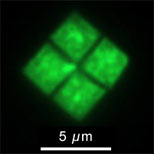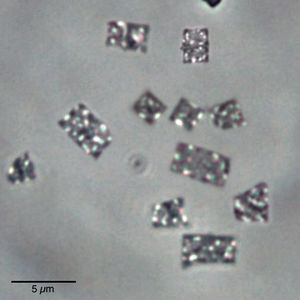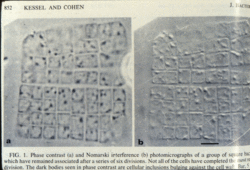Haloquadra
|
NCBI: |
Classification
Higher order taxa:
Archaea, Euryarchaeota, Halobacteria, Halobacteriales, Halobacteriaceae, Haloquadra
Description and Significance
These organisms are interesting to scientists because of their unique shape, their motility, and their relative abundance in halophilic habitats, possibly signifying an important ecophysiological role. They measure as large as 5x5 microns. While Haloquadratum walsbyi was discovered in 1980, it was not successfully cultivated in the lab until 2004; before then it had been considered to be an unculturable organism.
Genome Structure
Haloarcula quadrata's 16S rDNA provided scientists with a definite answer as to the organism's taxonomy; however the species' complete genome has yet to be sequenced. The mapping of the organism's 3.1 Mb large genome is underway; once this sequence is complete, scientists will have a better understanding of the role Haloarcula quadrata plays in its ecosystem.
Cell Structure and Metabolism
Haloarcula quadrata's unique cell shape--that of an extremely thin square--is its best-known characteristic. The cells possess an abundance of intracellular refractile bodies known as gas vacuoles vacuoles filled with gas which provide buoyancy, maintaining upper position in the water column. Individual square cells are joined with others to form large sheets, sometimes as large as 40 microns. These sheets are extremely fragile and the connections between the cells are easily broken.
The cells are motile by flagella, of which they can have anywhere between one and several located all over the cell surface. The flagella rotate clockwise to propel the cell forward; counterclockwise to move in reverse. Its mode of metabolism is not completely known; complete genetic information will give researchers necessary insight.
Ecology
Haloarcula sp. were first noticed and taken from saline pools in Egypt, but they can be found in hypersaline bodies of water all over the world. Evaporation of water in these pools leaves high concentrations of salt, making for Haloarcula quadrata's optimal growth environment. Their precise role in the ecosystem is not known for sure, but because of its unique morphology learning more about it will surely provide some information on the evolution and morphological adaptation of archaeans.
References
Dyall-Smith, Mike. The Square Haloarchaea of Walsby--one of the weirdest extremophiles. Department of Microbiology and Immunology, University of Melbourne.
Haloquadratum walsbyi. Department of Membrane Biochemistry, Max Planck Institute of Biochemistry.



